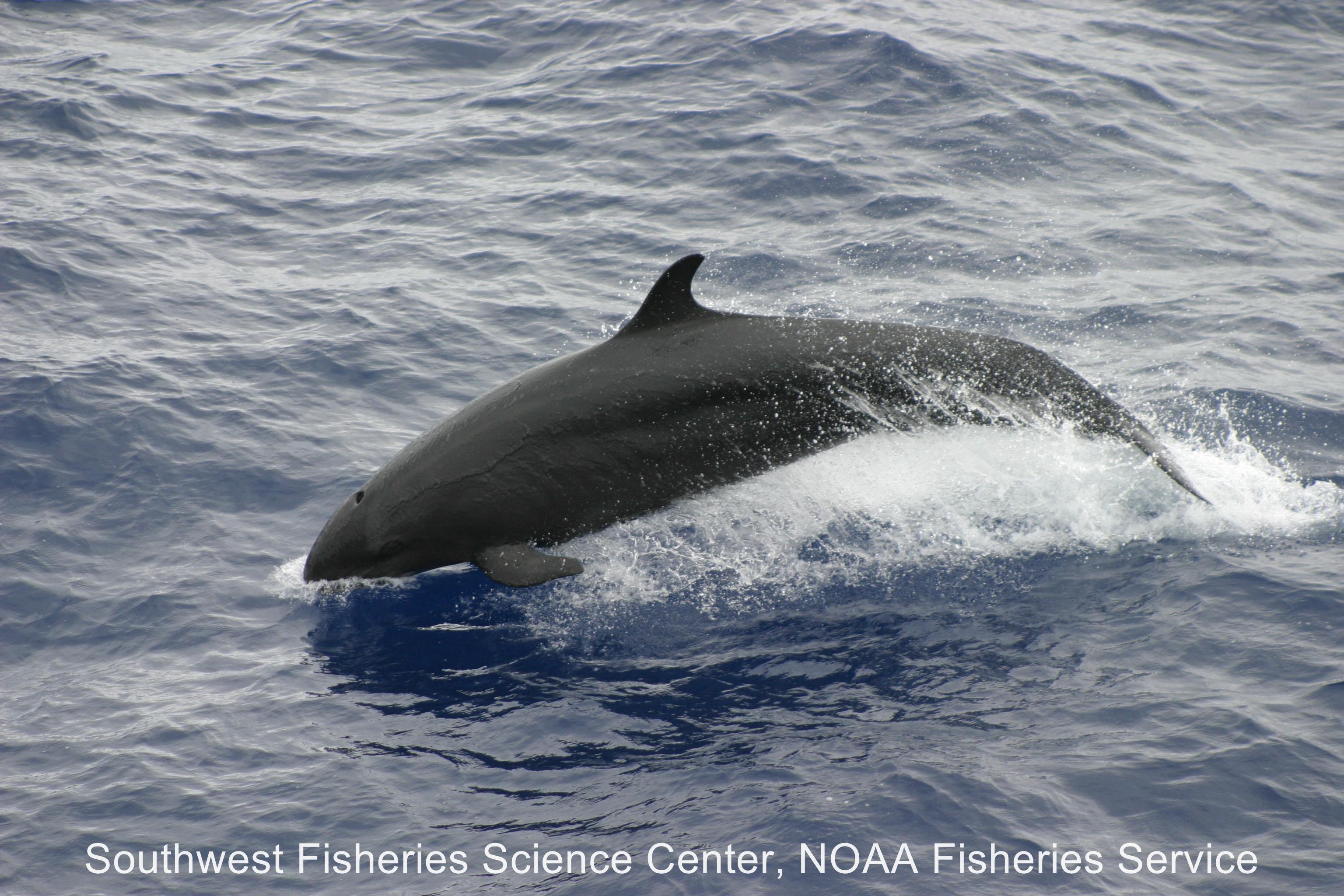News and Announcements
Press Release – Western Pacific Scientists Found “Weak Hook” Study Inconclusive as a False Killer Whale Mitigation Strategy ( 15 March 2022)

False killer whale. Photo: NOAA Southwest Fisheries Science Center.
HONOLULU (15 March 2022) The Scientific and Statistical Committee (SSC) found that a National Marine Fisheries Service 2021 “weak hook” study was inconclusive and did not provide scientific support for adopting weaker hooks as the primary strategy for reducing impacts to false killer whales (FKWs) in the Hawai‘i deep-set longline fishery. The study investigated the economic impacts of existing weak (4.5 mm diameter) and comparatively weaker (4.2 mm) hooks on target catch, primarily bigeye tuna. The study results showed the weight and value of bigeye tuna was higher for those caught on existing hooks than the weaker hooks.
The SSC noted that the weak hook approach is a flawed strategy that has been ineffective, highly stressful to FKWs and dangerous for fishermen as it necessitates creating tension on the line to attempt hook straightening. FKWs may become hooked on longline fishing gear because the whales feed on bait and fish caught on the line. Interactions between the Hawai‘i deep-set longline fishery and FKWs are rare—on average less than 10 are observed hooked or entangled each year.
SSC members reiterated their previous position that a better strategy would be to cut the line as close to the hook as possible so that the animal can be released quickly with minimal trailing gear that may cause further injury. “Gear release mechanisms that slide down the fishing line to cut near the hook are undergoing development and would be a better option than using weaker hooks,” said David Itano. “The fleet’s transition to monofilament nylon leaders is a game changer,” added Craig Severance. “It will allow fishermen to use simpler, less expensive line-cutting devices.”
Under the False Killer Whale Take Reduction Plan, fishermen are required to use 4.5 mm or less diameter wire hooks intended to straighten and release accidentally hooked FKWs, while retaining bigeye tuna and other fish species of market value. However, this weak hook has not been successful, with only approximately 10% of the interactions resulting in the hook straightening since the Plan’s implementation in 2013.
The SSC also heard a report on American Samoa Bottomfish Fisherman Data Workshops held in February 2022. SSC members emphasized that the information gleaned from these workshops would be helpful for the 2023 stock assessment.
The workshops highlighted several data issues, such as difficulties with distinguishing between similar species and gaps in data caused by lack of data collection, not lack in catches. Workshop participants included commercial and noncommercial fishermen, village leadership, and American Samoa Dept. of Marine and Wildlife Resources, Pacific Islands Fisheries Science Center and Council staffs. Fishermen provided both current and historical (1960s and ‘70s) bottomfish fishery insights that will help scientists to resolve discrepancies in the data for the 11 managed bottomfish species.
The SSC meeting continues tomorrow with discussions on 2021 Hawai‘i and American Samoa longline fishery status, area-based management and a new Pacific strategy for addressing international fishery management issues.
Scientific and Statistical Committee: James Lynch (Sierra Pacific Industries) (chair); Debra Cabrera (University of Guam); Frank Camacho (University of Guam); Milani Chaloupka (University of Queensland); Erik Franklin (University of Hawai‘i, School of Ocean and Earth Science and Technology); Jay Gutierrez (Guam Div. of Aquatic and Wildlife Resources); Shelton Harley (Minister of Fisheries, NZ); Jason Helyer (Hawai‘i Div. of Aquatic Resources); Ray Hilborn (University of Washington); Justin Hospital (NMFS PIFSC); David Itano (fisheries consultant); Donald Kobayashi (NMFS PIFSC); Steve Martell (SeaState, Inc.); Domingo Ochavillo (American Samoa Dept. of Marine and Wildlife Resources); Graham Pilling (Secretariat of the Pacific Community); Kurt Schaefer (Inter-American Tropical Tuna Commission); Craig Severance (University of Hawai‘i at Hilo, retired); Michael Tenorio (CNMI Div. of Fish and Wildlife); and Michael Seki (ex-officio) (NMFS PIFSC).
Western Pacific Regional Fishery Management Council: Secretary of Commerce appointees from nominees selected by American Samoa, CNMI, Guam and Hawai‘i governors: Roger Dang, Fresh Island Fish Co. (Hawai‘i) (vice chair); Manny Dueñas, Guam Fishermen’s Cooperative Association (Guam) (vice chair); John Gourley, Micronesian Environmental Services (CNMI) (vice chair); Will Sword, noncommercial fisherman/engineer (American Samoa) (vice chair); Monique Amani, business owner (Guam); Howard Dunham, commercial fisherman (American Samoa); Matt Ramsey, Conservation International (Hawai‘i); and McGrew Rice, charter boat captain (CNMI). Designated state officials: Anthony Benavente, CNMI Dept. of Lands and Natural Resources; Suzanne Case, Hawai‘i Dept. of Land & Natural Resources; Chelsa Muña-Brecht, Guam Dept. of Agriculture; and Archie Soliai, American Samoa Dept. of Marine & Wildlife Resources (chair). Designated federal officials (voting): Michael Tosatto, NMFS Pacific Islands Regional Office. Designated federal officials (nonvoting): Charles Brinkman and Rebecca Wintering, U.S. Dept. of State; Brian Peck, U.S. Fish and Wildlife Service; and RADM Matthew Sibley, U.S. Coast Guard 14th District.
